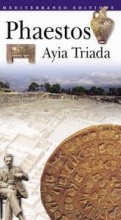Phaestos
Ayia Triada
Φαιστός: Αγία Τριάδα
High on a hill and controlling the plain of the Mesara - the largest and most fertile plain on Crete - from one end to the other, stands the Palace of Phaestos, the second most important palace of the Minoan world after Knossos and one of the four magnificent palaces of Crete. The Palace of Phaestos was discovered during excavations conducted by the Italian Archaeological School in 1900, immediately after the proclamation of the "Cretan State". The first head of the School was the archaeologist Federico Halbherr, who was subsequently succeeded by Luigi Pernier and after the Second World War, by Doro Levi. Three kilometres to the west of Phaestos lies the Minoan villa complex of Ayia Triada, which takes its name from the Venetian village to the east of the archaeological site. This royal villa or small palace, which most probably constituted the summer residence of the ruler of Phaestos, came to light in 1902, when the Italian Archaeological School arrived in the area.
- ISBN978-960-8227-37-8
- Ημ/νια Έκδοσης2004
- Σελίδες48
- ΔέσιμοΜαλακό εξώφυλλο
- Γλώσσα ΠρωτότυπουΕλληνικά
- Διαθέσιμες Γλώσσες
- Θεματολογίες Βιβλίου
- Συγγραφέας
- Εκδότης

